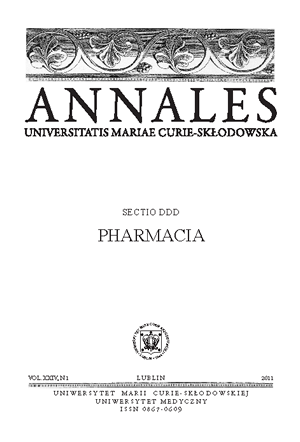A comparison of quantitative analysis of selected flavonoid glycosides from inflorescence of Sambucus nigra L. by Thin Layer Chromatography and High Performance Liquid Chromatography.
Keywords:
extraction methods, flavonoids, Sambucus nigra L., HPLC, TLCAbstract
Flavonoids are substances which have most important activity (anti-oxidative, anti-thrombotic, hypotensive, antiphlogistic). Because of that, there is a need to develop adequate methods for the isolation and analysis of these substances in plant material. The aim of this work was comparison of TLC quantitative analysis and HPLC quantitative analysis of flavonoid glycosides (rutin and isoquercetrin) from inflorescence of Sambucus nigra L. (Familia Caprifoliaceae). Samples were prepared by extraction of plant material with methanol or 80% methanol in water. The following methods were used: Soxhlet extraction, microwave assisted solvent extraction (MASE), accelerated solvent extraction (ASE) and ultrasound assisted solvent extraction (USAE). Samples containing flavonoid fraction were purified by SPE C18 cartridges and analyzed by HPLC. Simultaneously quantitative analysis of rutin and isoquercetrin in crude flavonoids extracts by performing TLC methods was carried out. In our experiments similar effectiveness of both methods for quantitative analysis of rutin and isoquercetrin from Sambuccus nigra L. inflorescence was ascertained.
References
1. Albu S. et al.: Potential for the use of ultrasound in the extraction of antioxidants from Rosmarinus officinalis for the food and pharmaceutical industry. Ultrasonics Sonochem., 11, 261, 2004.
2. Benthin B., Danz H., Hamburger M.: Pressurised liquid extraction of medicinal plants. J. Chromatogr. A, 837, 211, 1999
3. Dajas F. et al.: Neuroprotection by flavonoids. Braz. J. Med. Biol. Res., 36, 1613, 2003.
4. Folts J.D.: Potential health benefits from the flavonoids in grape products on vascular disease. Adv. Exp. Med. Biol., 505, 95, 2002.
5. Garcia-Ayuso L.E., Luque de Castro M.D.: Employing focused microwaves to counteract coventional Soxhlet extraction drawbacks. Trends in Anal. Chem., 20, 28, 2001.
6. Giannuzzo A.N. et al.: Supercritical fluid extraction of naringin from the peel of Citrus paradisi. Phytochem. Anal., 14, 221, 2003.
7. Hong N. et al.: Microwave-assisted extraction of phenolic compounds from grape seed. Nat. Prod. Lett., 15, 197, 2001.
8. Huang J., Zhang Z.: Microwave-assisted extraction of quercetin and acid degradation of its glycosides in Psidium guajava leaves. Anal. Sci., 20, 395, 2004.
9. Kaufmann B., Christen P.: Recent extraction techniques for natural products: microwave-assisted extraction and pressurised solvent extraction. Phytochem Anal.,13, 105, 2002.
10. Kohlmünzer S.: Farmakognozja. PZWL, Warszawa 1993.
11. Li H., Chen B., Yao S.: Application of ultrasonic technique for extracting chlorogenic acid from Eucommia ulmodies Oliv. Ultrasonics Sonochem., 12, 265, 2005.
12. Luque de Castro M.D., Garcia – Ayuso L.E.: Soxhlet extraction of solid materials: an outdated technique with a promising innovative future. Analytica Chimica Acta, 369,
1, 1998.
13. Lyseng-Williamson K.A., Perry C.M.: Micronised purified flavonoid fraction: a review of its use in chronic venous insufficiency, venous ulcers and haemorrhoids. Drugs, 63, 71, 2003.
14. Robak J., Gryglewski R.J.: Bioactivity of flawonoids. Pol. J. Pharmacol., 48,
555, 1996.
15. Scalia S., Giuffreda L., Pallado P.: Analytical and preparative supercritical fluid extraction of chamomile flowers and its comparison with conventional methods. Mass. Spectrom., 18, 211, 2004.
16. Snyder L.R, Kirkland J.J, Glajch J.L.: Practical HPLC method development. John Wiley & Sons, INC. New York 1997.
17. Waksmundzka-Hajnos M. et al.: Effect of extraction method on the yield of furanocoumarins from fruits of Archangelica officinalis Hoffm. Phytochem. Anal., 15, 313, 2004.
18. Waksmundzka-Hajnos M. et al.: Influence of the extraction mode on the yield of some furanocoumarins from Pastinaca sativa fruits. J. Chromatogr. B, 800, 181, 2004.
19. Waksmundzka-Hajnos M. et al.: Effect of sample preparation methods on the quantitation of selected flavonoids in plant materials by high performance liquid chromatography, Acta Chromatogr., 20, 475, 2008.
20. Zgórka G.: Retrntion behavior of silica-bonded and novel polymeric reversed-phase sorbents in studies on flavones as chemotaxonomic markers of Scutellaria L.genus. J. Chromatogr. A, 1120, 230, 2006.
Downloads
Published
Issue
Section
License
Copyright (c) 2011 Authors

This work is licensed under a Creative Commons Attribution-NonCommercial-NoDerivatives 3.0 Unported License.


